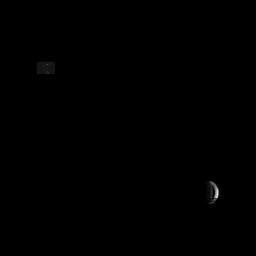- Original Caption Released with Image:
-
NASA's Galileo spacecraft, now in orbit around Jupiter, returned this optical navigation image June 3, 1996, showing that the spacecraft is accurately targeted for its first flyby of the giant moon Ganymede on June 27. The missing data in the frame is the result of a special editing feature recently added to the spacecraft's computer to transmit navigation images more quickly. This is first in a series of optical navigation frames, highly edited onboard the spacecraft, that will be used to fine-tune the spacecraft's trajectory as Galileo approaches Ganymede. The image, used for navigation purposes only, is the product of new computer processing capabilities on the spacecraft that allow Galileo to send back only the information required to show the spacecraft is properly targeted and that Ganymede is where navigators calculate it to be. "This navigation image is totally different from the pictures we'll be taking for scientific study of Ganymede when we get close to it later this month," said Galileo Project Scientist Dr. Torrence Johnson. On June 27, Galileo will fly just 844 kilometers (524 miles) above Ganymede and return the most detailed, full-frame, high-resolution images and other measurements of the satellite ever obtained. Icy Ganymede is the largest moon in the solar system and three-quarters the size of Mars. It is one of the four large Jovian moons that are special targets of study for the Galileo mission. Of the more than 5 million bits contained in a single image, Galileo performed on-board editing to send back a mere 24,000 bits containing the essential information needed to assure proper targeting. Only the light-to-dark transitions of the crescent Ganymede and reference star locations were transmitted to Earth. The navigation image was taken from a distance of 9.8 million kilometers (6.1 million miles). On June 27th, the spacecraft will be 10,000 times closer to Ganymede.
- Image Credit:
-
NASA/JPL
Image Addition Date: -
1996-06-06
|

 Planetary Data System
Planetary Data System












